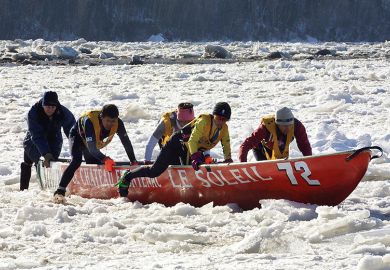In the 1870s, a samurai called Yamada Akiyoshi travelled to the US and Europe to study Western practices. He went on to develop Japan’s modern legal code as his country’s first justice minister, and to help found two universities including Nihon Law School – subsequently renamed Nihon University, Japan’s largest.
Now Nihon has returned to its roots, venturing overseas to establish Japan’s first offshore university campus in a restored heritage courthouse – ironically established the same year as Nihon – in the Australian city of Newcastle.
For a sector with almost 1,000 universities and an enviable tally of Nobel prizes, Japan is a surprisingly small player in international higher education. It hosts relatively few foreign students and university branches and has sprouted very few outposts on foreign soil.
Now it is taking baby steps to change that, after Japan’s Education Ministry last year pledged ¥1.5 billion (£8 million) to help establish foreign branch campuses.
Nihon received no special ministry funding for its Newcastle site, which was acquired in 2016 and completed in 2021 during the coronavirus pandemic. Operations began early this year in the form of three-week programmes – in English language, global issues, crisis management and sports science – for its Tokyo-based students.
The facility’s official opening on 22 August only narrowly preceded the University of Tsukuba’s 1 September inauguration of its Malaysia campus – Japan’s first offshore university branch providing degree-level education – in the grounds of the University of Malaya in Kuala Lumpur.
The two campuses join a smattering of overseas facilities spawned decades ago by private Japanese universities or their founding entities. They include Chaucer College, a language school in the grounds of the University of Kent, and Hawaii Tokai International College, a vocational education provider in Honolulu. Toyota Technological Institute at Chicago, established by a small Nagoya engineering school, provides doctoral education in computer science.
Enrolments at these facilities range from a few hundred to a dozen or so. Nihon president Ohnuki Shinichiro said his Newcastle campus had accommodation for 100 students, although the university would consider catering to larger classes.
Professor Ohnuki said the Japan of the future would need more university graduates acquainted with Japanese language and culture. “The progressive decline in population – that’s the most critical issue facing Japan today. Japan will need to actively accept human resources from outside Japan. We’re thinking seriously about this issue.”
He said the Newcastle campus could also help generate international enrolments on home soil, with Australians heading to Tokyo to study Japanese language, law, science, technology, medicine and Japanese pop culture.
Nihon is a huge operation even by Australian standards. It boasts about 117,000 students – some 74,000 undergraduates, 3,000 postgraduates and tens of thousands more in its affiliated network of 51 schools, a vocational college and a kindergarten. But it attracts only about 1,700 international students, mostly undergraduates from China and South Korea.
Professor Ohnuki said Nihon had chosen to locate its first overseas campus in Australia because it was a multicultural, English-speaking country that overlapped Japan’s time zone. As a “safe” regional city, much more “compact” than nearby Sydney, Newcastle was a “very suitable” place to send its students.
Nihon is thinking about broadening the Newcastle operation to include degree programmes and research. Professor Ohnuki said an overseas campus was an important “branding” exercise for Nihon, in a university sector facing both demographic and fiscal challenges.
“There are currently nearly 800 universities in Japan. In order to survive – to continue to be chosen by students – we need to make sure they are satisfied with our global perspective,” he said.
Hiroshima University internationalisation expert Futao Huang said overseas campuses were “relatively inexpensive ways” of enhancing Japanese universities’ prestige. Their primary purpose was neither to foster an inflow of foreign recruits nor to facilitate outward mobility for Japanese students.
“The emphasis is on broadening the global presence of Japanese universities and internationalising learning opportunities,” Professor Huang said.
Waseda University higher education researcher Christopher Pokarier said institutions that were struggling to compete domestically often looked to international partnerships and programmes “for product differentiation and a branding boost”.
“A formal campus presence overseas tends to be an extension of that,” Professor Pokarier said. “While the educational intent is sound, the realities of what their student cohorts are ready for – and the institutions are capable of delivering in practice – often intrude.”
The University of Newcastle is supporting Nihon’s Australian operation and exploring joint courses and twinning programmes in areas including sports and languages. “We don’t see them as a competitor,” said vice-chancellor Alex Zelinsky. “We see them as an asset to the city and potentially a partner.
“I want to see the Australian higher education system diversify. There’s plenty of scope for collaboration. Japan [is] still one of the largest economies in the world. If you look at…national security, it’s a natural partner to Australia.”
Register to continue
Why register?
- Registration is free and only takes a moment
- Once registered, you can read 3 articles a month
- Sign up for our newsletter
Subscribe
Or subscribe for unlimited access to:
- Unlimited access to news, views, insights & reviews
- Digital editions
- Digital access to THE’s university and college rankings analysis
Already registered or a current subscriber? Login










